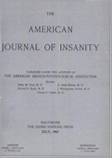Abstract
This is an analytical and follow-up study of 250 children of pre- school age, from an observation nursery of a psychiatric division of a city hospital, covering a five-year period.
Half of these children were mentally defective, and the majority of these were transferred to suitable state institutions. This service could undoubtedly be rendered in many instances without an observation ward. However, in many cases apparent retardation was found to be due to neglect in very poor homes or isolation in institutions, and tended to correct itself in the ward situation which we had to offer. The experience of the staff of psychiatrists, pediatricians, psychologists and nursery teachers and nurses was further enriched by the group of more or less obviously defective children, enabling them to better evaluate, treat and prognosticate borderline problems, children temporarily retarded and many non-defective organic problems, as well as older children who came with similar but less severe problems, often with a less well-defined history.
In regard to children with mental deficiency and organic brain disease, special insight was gained in many problems such as the relation of prematurity to behavior disturbances and developmental tendencies, the significance of non-specific encephalopathies in early infancy, some types of infantile dementias, special language disabilities and many significant social problems such as illegitimacy, early institutional care, the neglected negro infant, etc., and the developmental curves of intellectual functioning.
Among the non-organic and non-defective problem children under the age of 6, several points are worthy of emphasis.
From foundling hospitals which institutionalize the child the first few years, or from child-placing agencies not sufficiently psychiatrically minded to give emotional security to their young children, we have a series of special behavior problems of very severe grade with infantile, hyperkinetic and asocial features, which are resistive to therapy and which we designate as the psychopathic personality of childhood. These children also show a retardation in IQ which tends slowly to rise until about the age of 9, when it may fall due to poor school adjustment, social immaturity and distractibility. These children, who are serious social menaces, cannot be cured but their behavior disorders could be prevented.
Dull children from the best type of child-placing agency seem to suffer from the usual mechanisms of rejection, rivalry, and feelings of inferiority for which the foster homes do not seem, in some cases, to offer sufficient compensation or understanding. Such children respond to the service and recommendations we have to offer.
Neglected young children sent to us from the children's court often show apparent retardation and emotional blocking due to association with grossly psychotic, defective or psychopathic parents but respond readily to the care offered them.
A remaining group of bright children are referred from their own homes due to the usual neurotic disorders of this age, often much exaggerated. They are children from homes of quarreling, infantile parents or severely rejecting mothers who never wanted the child from the first. They are often "only" children. They require a long course of supervised psychotherapy either in their own or another home, but are finally responsive.
One of the greatest functions of this service is that it has given us a deeper understanding of the infant and early child neurophysiology, intellectual and emotional development, and the child as a unit of a social group. We have learned that the infant cannot be raised in an institution without risking his normal personality development; we have learned that the only safeguard for the normal development of a child is a unified and continuous home environment for the first several years. The lack of this can never be compensated for. The child may be abused by psychotic, criminal and defective parents and may recover, however. A dull child may need more than the average foster home can give him. A bright child suffers from quarreling and rejecting parents but may respond to therapy with or without a change in the environment.
For mental deficiency and/or organic brain disease in childhood there is no simple formula. There are innumerable syndromes which we have only begun to classify. Each syndrome carries with it its own family social-and psychopathology, its own brain and somatic structure, its own developmental curve and its own behavior pattern. A fuller understanding of any of these syndromes even of gross deviates may throw a strong light on our insight into children who are borderline problems and often potentially normal.

